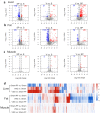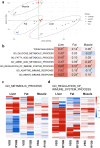Vertical sleeve gastrectomy induces distinctive transcriptomic responses in liver, fat and muscle
- PMID: 33504853
- PMCID: PMC7840766
- DOI: 10.1038/s41598-021-81866-5
Vertical sleeve gastrectomy induces distinctive transcriptomic responses in liver, fat and muscle
Abstract
Vertical sleeve gastrectomy (VSG) is the most commonly performed bariatric/metabolic surgery, exhibiting a high rate of diabetes remission in humans. To elucidate the molecular mechanisms of VSG, we performed transcriptomic analysis of the liver, fat, and muscle in VSG mice. C57BL/6 mice fed a high-fat diet were randomly assigned to sham or VSG surgery. The sham-operated mice were fed ad libitum (sham group) or pair-fed (sham-PF group) matching their food intake to the VSG-operated mice. Comparative transcriptomic analysis of the liver, fat, and muscle using RNA sequencing was performed. VSG reduced body weight and improved glucose tolerance compared to the sham group, but not more than the sham-PF group. Improvement in fatty liver and adipose tissue inflammation was comparable between VSG and sham-PF. However, global gene expression profiles showed distinctive changes in the liver, fat, and muscle of the VSG group compared to both the sham or sham-PF groups. The liver showed the most prominent gene expression changes. Immune response-related pathways were commonly upregulated in the three organs of the VSG group compared to the sham or sham-PF. VSG induces organ-specific gene expression changes in the liver, fat, and muscle, which may play critical roles in metabolic improvements after VSG.
Conflict of interest statement
The authors declare no competing interests.
Figures





References
-
- The International Federation for the Surgery of Obesity and Metabolic Disorders. Fifth IFSO Global Registry Report 2019 (2019).
Publication types
MeSH terms
Substances
Grants and funding
LinkOut - more resources
Full Text Sources
Other Literature Sources

